Benchmark DAC1 HDR
- 07 Jul 2009 11:41
- 1062

Benchmark Media Systems, Inc., 203 East Hampton Place, Suite 2, Syracuse, NY 13206-1633. Voice: (315) 437-6300. Fax: (315) 437-8119. E-mail: sales@benchmarkmedia.com. Web: www.benchmarkmedia.com. DAC1 HDR stereo preamplifier with remote control, digital-to-analog converter, headphone amplifier, and computer audio interface, $1895.00. Tested sample on loan from manufacturer.
In March 2005, I posted a review of the Benchmark DAC1, the granddaddy of this new model. (You can find the review under Archives.) I found the DAC1 to be essentially perfect—almost as perfect as the Audio Precision measuring instrument itself. The DAC1 was strictly a 24-bit 192-kHz digital-to-analog converter, nothing more. The DAC1 HDR incorporates the DAC1 unchanged and adds to it what is basically a complete front end for a stereo system: line-level preamp, remote control of volume and inputs, headphone amplifier, and USB computer audio interface.

As I pointed out in the original review, more expensive DACs than the Benchmark give you absolutely nothing more in performance—you can’t outperform perfection. Benchmark audio equipment is made by professionals for professionals. Their aim is to achieve the ultimate in measurements. That leaves the “pride of ownership” of five-figure audio jewelry to the orthopedic surgeons, hedge-fund managers, and drug dealers to whom the dollar sign is an index of listening quality. I can just repeat the same statements when it comes to the DAC1 HDR. It isn’t cheap—almost twice the price of the DAC1—but it doesn’t use inflated price as a marketing tool and is exactly as good as it needs to be: a totally transparent conduit for audio signals.
The Design
The HDR is no bigger than the original DAC1; it is built on the same 8-inch square chassis in the style of the increasingly popular half-size audio components. The additional complexity and parts density of the design result in a slightly higher operating temperature; the difference isn’t significant, since neither model runs very cool. The DAC circuitry is the same as before; the additional analog circuitry is implemented with National Semiconductor LM4562 op-amps. The LM4562 is a very advanced, low-distortion dual unit; its THD specification is 0.00003%, which translates to –130.5 dB! Not that anyone can measure –130 dB directly with any standard test instrument; that spec must be based on some sort of indirect calculation. (The only comparable op-amp known to me is the Analog Devices AD797, which is a single-channel unit; a pair of them constitute the heart of the Morrison E.L.A.D. line-level preamp, which I have been using since 1998 because there is nothing better at any price. I’ve had recent discussions with Don Morrison, who still prefers the AD797 to the LM4562 but admits that the latter is the competition.)
The volume control of the DAC1 HDR is based on a motorized Alps potentiometer custom-made for this model and remotely controllable. Its gain circuit is designed to maintain the full dynamic range of the unit’s audio signal path, unlike digital volume controls that limit the dynamic range at various settings. This is the feature that sells me most decisively on this preamp/DAC. It consolidates and refines an ultrasophisticated nerve center for a stereo system on a single tiny chassis. Everything you need is there. Another design feature I particularly like is the choice of two headphone amplifier output jacks, one of which mutes the main analog outputs and the other one doesn’t. That makes a lot of sense—sometimes you just want to listen to your headphones and sometimes you want to compare the headphone sound with the loudspeaker sound. USB audio is yet another important feature, which I haven’t tried yet; using a laptop for my main program source will be the next step in my technological evolution. The USB input is plug-and-play, compatible with all current operating systems, and it supports sampling rates up to 96 kHz and word lengths up to 24 bits. The instruction manual devotes 23 pages to the description and features of the DAC1 HDR; I have merely scratched the surface here. The unit is a high-tech feast. Go to the Benchmark website for more details.
The Measurements
To my great surprise, the 14 pages of Audio Precision performance graphs in the DAC1 HDR instruction manual are all about the original DAC1 and are all dated 2002. The assumption is that, since the original DAC1 is incorporated unchanged in the HDR, the digital-in-analog-out performance measurements remain the same. Very well then, let us accept the validity of that assumption—but where are the new analog-in-analog-out data? The original DAC1 did not have an analog input, nor a motorized potentiometer through which the analog signals passed. I found this omission to be astonishing and necessarily started my measurements with analog in and out.
Fig. 1 shows the graph that basically gives you the total picture, THD+N versus frequency. You don’t really need anything else. As it turns out, Benchmark could afford to omit this measurement because it resembles that of a straight wire. Both channels hug the line at –105 dB (0.00056%) distortion at just under 2 volts output, where the distortion appears to bottom out. That equals the performance of the Morrison preamp mentioned above, which has been the THD champion for the past 11 years (at least in my experience). Those LM4562’s are certainly doing the job. What’s more, the true measurements for the Benchmark are probably even better by a couple of dB because I measured it with the Audio Precision ATS-2, which has a THD+N floor a few dB higher than the state-of-the-art SYS-2722 I used to have but no longer do.
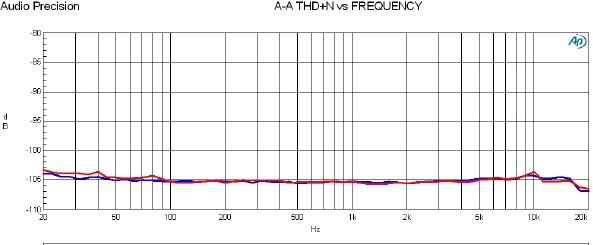
Fig. 1: Distortion across the audio spectrum, analog input, just under 2 volts output, both channels.
To check the effect of the Alps potentiometer on the channel separation, I measured the crosstalk with analog input at 1 volt out. Fig. 2 shows a classic declining response starting at –65/–72 dB at the highest frequencies and dropping to –125/–133 dB at the lowest. You can’t ask for better. (If you go to Archives, March 2005, and check out the crosstalk of the original DAC1 with digital input, you’ll see even better figures, but that is partly because of the much higher output with 0 dBFS input.)
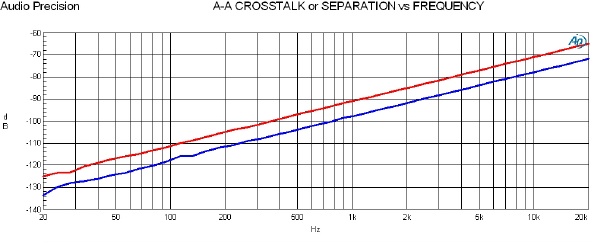
Fig. 2: Channel separation, analog input, 1 volt output, both channels.
As I said, I’m willing to believe that the D-to-A part of the HDR is identical to the original DAC1, so I just spot-checked a few performance results. Again, I refer you back to Archives, March 2005, for the comparison. THD+N versus frequency with –3 dBFS input (Fig. 3) is worse by an average of 2.5 dB, but that is easily explained by the difference between the Audio Precision ATS-2 and SYS-2722. Gain linearity and deviation from linearity (Fig. 4) are exactly the same, and intermodulation distortion at full scale (Fig. 5) is only microscopically different, if at all. I would say that Benchmark is, in the final analysis, justified in using DAC1 data for the digital specs of the DAC1 HDR.
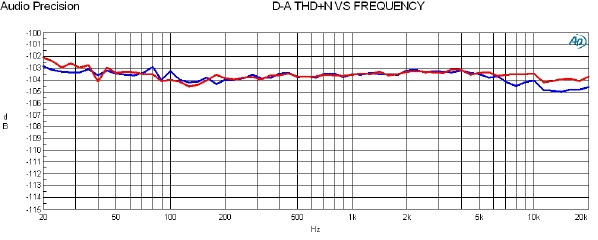
Fig. 3: Distortion across the audio spectrum, digital input at –3 dBFS, both channels.
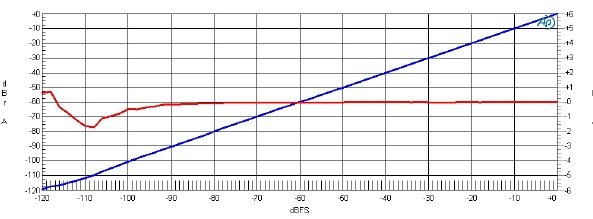
Fig. 4: Gain linearity (blue) and deviation from linearity (red) in one channel.
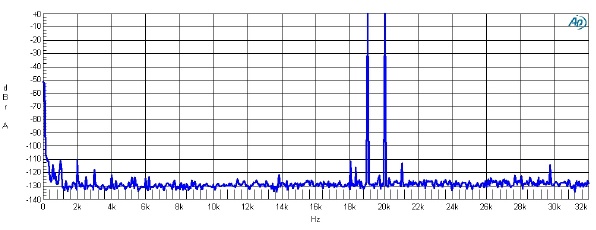
Fig. 5: Intermodulation distortion, digital input at 0 dBFS, 19 kHz + 20 kHz, in one channel.
I could have made many more measurements but I am (1) getting lazy in my old age and (2) reluctant, as always, to belabor the obvious. The Benchmark DAC1 HDR is state-of-the-art.
The Sound
I am adding this paragraph strictly for the sake of my newer readers. The old regulars know exactly my position regarding the stupidity of ascribing a “character” to the sound of an utterly neutral signal path. Oohing and aahing over the vast improvement in soundstaging, front-to-back depth, bass delineation, or treble sweetness obtainable with this or that electronic component may sell high-end magazines but is totally unscientific and delusional. What the Benchmark DAC1 HDR adds to or subtracts from its input signal is borderline unmeasurable, so the sonic character of its output is obviously the sonic character of its input. It’s as simple as that. It has no sound of its own. Furthermore, its measurements could be 20 or 30 dB worse and it would still sound the same. I have convinced myself of that over and over again in double-blind listening comparisons of all sorts of electronic components at matched levels. The 100% purity of the DAC1 HDR is of benefit mainly in professional systems, where the integrity of the equipment chain needs to be verified and guaranteed. To audiophiles it’s a somewhat abstract luxury—but not an excessively costly one.
Conclusion
All in all, the Benchmark DAC1 HDR is damn close to a perfect piece of equipment. Neither its digital performance nor its analog performance could be meaningfully improved. That’s really all that needs to be said. If I could change anything at all about it, it would be to add a couple more analog inputs. I realize that there is no room for that, so I use a small input switch box that sits on top of it. Most users won’t need it. There exist DACs and preamps at ten times the price of the Benchmark, but they aren’t any better. Let the high-end police come and take me away in handcuffs.
